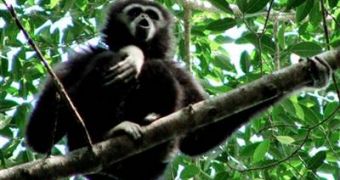1. Gibbons are the smallest living apes. They are restricted to the southeastern Asia (Indochina, and three big islands of Indonesia: Borneo, Sumatra and Java). Gibbons split from the line that evolved towards humans over 10 million years ago.
Experts say that all living gibbons evolved from one species, 2 million years ago.
There are 13 species of gibbons living today, but each one has its own areal separated from that of the others, because otherwise, species would have competed for the same food. There is one exception: the so-called siamang or larger gibbon, whose territory overlaps over that of 2 other species.
While the other species have the same size (about 6 kg or 14 pounds), the siamang reaches 13 kg (31 pounds). Being bigger, it cannot compete smaller species for fruits located on thin twigs. Moreover, the siamang eats mainly leaves, while other gibbons eat mainly fruits. Because of the leaf diet, the siamang can live also on small territories, while the other gibbons have to wander vast areas in search of fruits.
2. Gibbons are the only monogamous apes, which form "marriages" of one male and one female that last till the end of their lives. Because of the monogamy, gibbons are the only apes in which male and female have the same size. At intervals of 2-3 years, the female gives birth, following a gestation of 7-8 months, to a gibbon baby. The offspring is weaned when it is two years old. At 3 years old, the young gibbons are already independent. At 6 years old, the gibbon is fully developed, but it remains with the family for several years more till splitting for finding a mate to form its own family.
In siamang, the male too is involved in taking care of the baby.
A family is made by the pair and up to four offspring.
3. Gibbons are famous for their singing ability. These are the most beautiful "songs" emitted by a land mammal, being rivaled amongst mammals just by whales. Their songs can be heard 2-3 km (1.2-1.9 mi) away.
Some sing daily, other once at five days. They start in dawn and the song can last from 10 minutes to 2 hours. Usually, the male and the female form a duet. Larger young can join the parents. The siamang has a huge chin sac which swells during the singing, amplifying the emitted calls.
The singing has a social role. It is made of various types of sounds: screams, swishes, trills, whistles, chirps, and gurgles. Male and female can begin by warming up their voices, and after that they start to sing each one its aria one after another. In Kloss gibbons, the big aria is sung by the female.
To start singing, gibbons first climb up in the top of a tree. When they reach the climax of the song, gibbons start to jump from branch to branch, tearing leaves and twigs. All the members of the family participate in this family show.
The song signals to the neighboring families that the territory is occupied and till where its borders extend. The song also strengthens the bound between "spouses". This way, the females also signal to other females that the male whose voice they have just heard is "occupied".
4. Gibbons have extremely long arms. The nude face is always black skinned. Unlike other apes, gibbons have a right posture on land, and are the only apes that usually walk bipedal (on two feet), just like man. Being more primitive than other apes, scientists suggest that bipedism of the gibbons and men is primitive, and the knuckle walk of gorilla and chimp is a derived trait.
Gibbons are the fastest not apes, but monkeys, too, on trees. They can execute 15 m (50 ft) jumps from tree to tree, at a speed of 56 km/h (35 mph), without stopping. Gibbons are by far the fastest and most agile of all arboreal, non-flying mammals. Their stunts are allowed by the hook-like long digits, both on the fore and rear limbs.
5. Gibbons are active just in down and evening, resting during the hot midday. Like all apes, they sleep in a nest built in the trees, made of leaves and branches. In Kloss gibbons, the male sleeps alone.
Like in other apes and monkeys, the main social (except the singing) activity of the gibbons is deparasitizing.
As said, gibbons are territorial, and one square kilometers of forest can harbor 2-4 gibbon families. Gibbons roam 1-1.5 km (0.6-0.0 mi) daily in search of food. Siamang wanders less. Gibbons establish if a fruit is ripe or not just like humans: by pressing it between their fingers.
Beside fruits, gibbons eat also leaves, and for proteins, insects and spiders.

 14 DAY TRIAL //
14 DAY TRIAL //